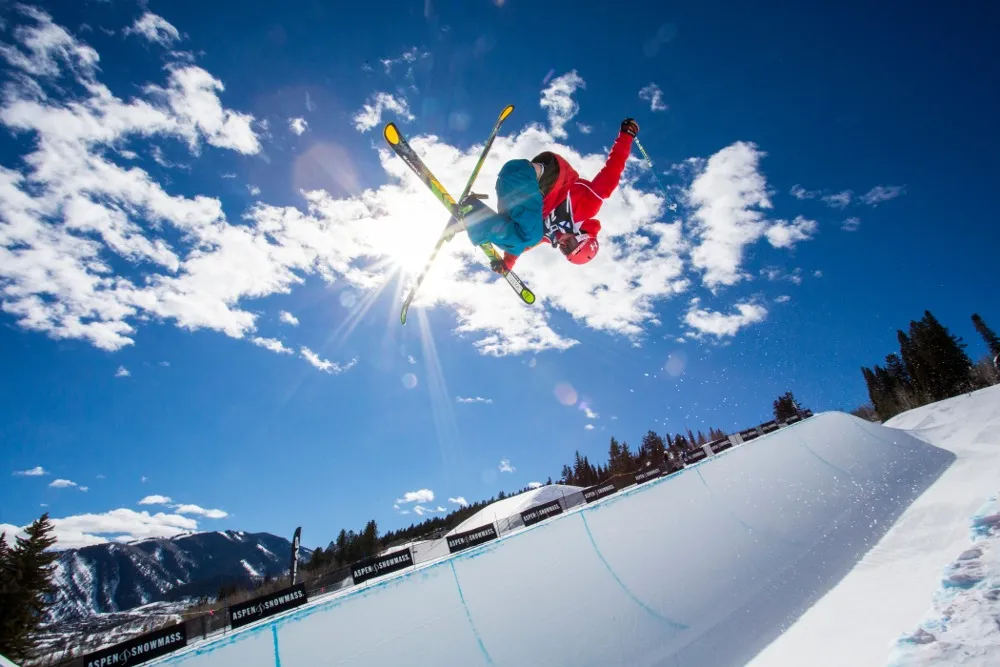#1 – Caballerial:
In order to successfully perform a Caballerial while freeskiing in a halfpipe format, a slopestyle format, freestyle format, or big air format, the skier must begin in the switch or fakie position as they approach the lip. As the rider clears the ramp, the next stop is to execute a 360-degree spin through the vertical axis, before finally sticking the landing in a forward-facing position.
#2 – Back Flip:
As straightforward as it would seem, the freeskiing backflip is executing by leaning back off a jump or ledge in order to complete a back-facing rotation through the vertical axis. Back flips can be perfected with some practice, and once a skier has the muscle memory down for this maneuver, it can become a powerful ally in one’s repertoire.
#3 – Front Flip:
To execute a front flip while freeskiing in virtually any format, the rider must lean into a forward-facing rotation through the vertical axis. Front flips while freeskiing are often more difficult than they look, and can be even harder than back flips because of the more strenuous and against-the-grain motion of generating forward inertial momentum through the front-facing rotational axis.
#4 – Flair:
When attempting to pull off a flair rotation, a freeskier should initiate a conventional back flip. After the back flip is initiated, the next step involves the incorporation of a 180-degree rotation through the horizontal axis. A flair is a really impressive freeskiing aerial, but it is definitely wise to familiarize one’s self with a conventional backflip before attempting a flair freeskiing aerial.
#5 – Rodeo (Rodeo Flip):
Conventionally performed with a 540-degree horizontally inverted rotational, the rodeo flip is a highly advanced trick that involves a modified-axis back flip. Although the freeskiing rodeo flip is often executed with a 540-degree flip, giving it the popular name “Rodeo 5”, it can also be performed with any degree of spin that a rider can accommodate through skill and training.
#6 – Basic Corkscrew or “Cork:”
A highly popular advanced level freeskiing aerial trick, the corkscrew or “cork” is another maneuver that, like the rodeo, involves off or modified-axis rotations. A skier must invert their basic single horizontal rotation, and their feet should never be directly above their head as they would be with a more conventional flip protocol.
#7 – Double Corkscrew or “Double Cork:”
Quite similar to the basic corkscrew or single cork, the double corkscrew or “double cork” is essentially a minor modification to the more typical cork making it more difficult and impressive by adding an extra off-axis flip. Just like the single cork, the rider’s feet should not go directly over the top of their head at any time. An inverted horizontal rotational is the essence of the double cork, with that rotational performed twice with the “double cork.”
• #8 – Lincoln Loop:
The Lincoln Loop is a great trick for intermediate to advanced freeskiers to consider attempting, and it is a relatively simplistic aerial though it is definitely not terribly easy. The Lincoln Loop is essentially performed by executing a single inversion, without allowing for any spin at all. This trick can basically be summarized by saying that the skier is almost cartwheeling, though they are rotating to the side in a kind of barrel-style roll pattern.
#9 – Misty (Misty Flip):
The misty flip is definitely on par with the rodeo flip when it comes to difficulty levels, but it is markedly different than the rodeo flip in terms of being front flip oriented instead of back flip oriented. What must be achieved in the process of executing a misty flip, is that the skier must enter a front flip rotation while horizontally spinning at least 180-degrees at one time. In summation, the misty flip is basically a modified-axis flip pattern moving forwards while incorporating a spin that is at least 180-degrees.
#10 – Flatspin:
Another highly impressive freeskiing aerial from a visual standpoint, the flatspin is not terribly complex, but at the same time it does take a lot of getting used to for some riders. In order to enter a successful flatspin pattern, the rider needs to assume a horizontal or inverted positioning, while at the same time executing a vertical-axis rotation of the degree of choosing for any given freeskier.
#11 – Underflip:
The underflip is fairly complex, unlike some of the more straightforward freeskiing aerial tricks listed in this directory. The procedure for successfully executing an underflip starts off with an initial 90-degree spin from the lip of a ramp, bank, or jump, followed up with a Lincoln Loop, and finally back into an additional 90-degree spinning pattern.
#12 – Double Daffy:
The double daffy is more or less a more difficult version of the basic daffy freeskiing aerial maneuver, as it seeks to double this motion into a repeat trick that constitutes the double daffy. What takes place within a double daffy maneuver is that the freeskier will end up kicking one of their legs in a forward motion while hanging the other leg back, and then reversing this motion by kicking the rear leg forward and the opposite leg backward. This can be a really cool trick when done right, and is sort of reminiscent of a airwalk from a visual perspective.
- Best Cutting Edge New Wakeboard Models for the Upcoming 2017 Season
- 2016 Red Bull Cape Fear Professional Surf Contest
- Pro Skimboarder Lucas Fink Is Taking Over The Rankings in 2019!
- Roaring Triumphs and Unforgettable Moments: Unveiling the Thrilling Recap of the 2016 GEICO Motorcycle Budds Creek National Final Results!


